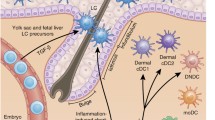Abstract
Langerhans cells constitute a morphologically well characterised subpopulation (3–8%) of mammalian epidermal cells which, in contrast to the bulk of epidermal cells, bear Fc-IgG and C3 receptors1, express immune response-associated (Ia) antigens and function as antigen-presenting cells and allogeneic stimulatory cells to primed T lymphocytes2–5. The ontogeny of Langerhans cells has been a subject of considerable debate since their discovery6. Although some studies suggest that Langerhans cells are of mesenchymal as opposed to neural or melanocytic origin7, direct evidence for this has not been presented. In this study we demonstrate that, after 3 weeks, most of the Langerhans cells (LC) in parental skin which had been transplanted on to F1 hybrids were of recipient origin whereas keratinocytes remained of donor origin; this indicates that the LC are derived from a mobile pool of cells. Furthermore, in studies of skin from radiation-induced bone marrow chimaeric animals we found that, depending on the strain combination, up to 80% of the epidermal LC were derived from the bone marrow of the donor animals.
Similar content being viewed by others
References
Stingl, G. et al. Nature 268, 245–246 (1977).
Rowden, G., Lewis, M. G. & Sullivan, A. K. Nature 268, 247–268 (1977).
Klareskog, L., Malmnas-Tjernlund, U., Forum, U. & Peterson, P. A. Nature 268, 248–250 (1977).
Stingl, G., Katz, S. I., Shevach, E. M., Wolff-Schreiner, E. Ch. & Green, I. J. Immun. 20, 570–578 (1978).
Stingl, G., Katz, S. I., Clement, L., Green, I. & Shevach, E. M. J. Immun. 121, 2005–2013 (1978).
Langerhans, P. Virchows Arch. path. Anat. Physiol. 44, 325–337 (1968).
Breathnach, A. S., Silvers, W. K., Smith, J. & Heyners, S. J. Invest. Derm. 50, 147–150 (1968).
Rowden, G., Phillips, T. M. & Delovitch, T. L. Immunogenetics 7, 465–478 (1978).
Tamaki, K., Stingl, G., Gullino, M., Sachs, D. H. & Katz, S. I. J. Immun. 123, 784–787 (1979).
Steinmuller, D. Transplant Proc. 1, 593–596 (1969).
Author information
Authors and Affiliations
Rights and permissions
About this article
Cite this article
Katz, S., Tamaki, K. & Sachs, D. Epidermal Langerhans cells are derived from cells originating in bone marrow. Nature 282, 324–326 (1979). https://doi.org/10.1038/282324a0
Received:
Accepted:
Issue Date:
DOI: https://doi.org/10.1038/282324a0
- Springer Nature Limited
This article is cited by
-
STR typing of skin swabs from individuals after an allogeneic hematopoietic stem cell transplantation
International Journal of Legal Medicine (2023)
-
Suggested Case of Langerhans Cell Histiocytosis in a Cretaceous dinosaur
Scientific Reports (2020)
-
Ontogeny and function of murine epidermal Langerhans cells
Nature Immunology (2017)
-
Irritierende Ergebnisse einer DNA-Analyse aus Mischspuren
Rechtsmedizin (2017)





